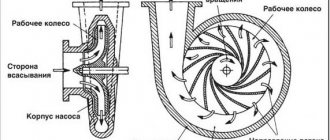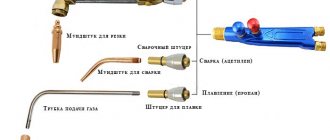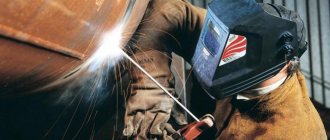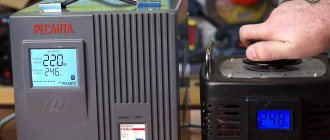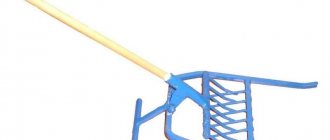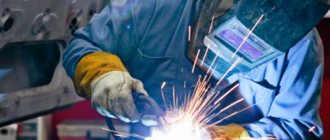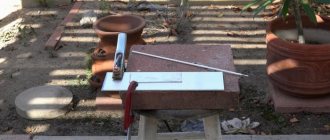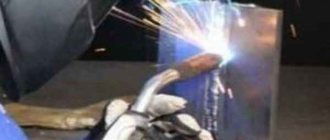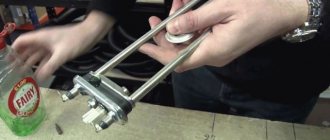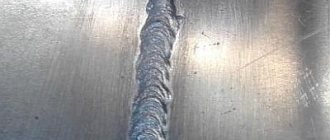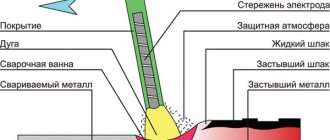Features of parts
A special approach to working with thin parts is explained by the fact that any involuntary or careless movement of the electrode can lead to burning of the metal at the welding site and creating an unwanted hole. But excessive caution is also not recommended, since slow welding does not exclude the possibility of damage to the workpiece.
This statement is true for the entire range of techniques used when working with electric welding, including the fusion of thin-sheet materials using a pulse inverter, a semi-automatic device, or a conventional (uncoated) electrode.
Let us consider each of the listed methods of welding sheet metal in more detail.
Flux for soldering stainless steel and its preparation
One of the most important issues that must be resolved before soldering is the choice of the most suitable flux. Sometimes experts prefer not to buy ready-made ones, but prepare consumables themselves. The classic recipe involves the use of the following elements:
- calcium fluoride – 10%;
- boric acid – 20%;
- borax – 70%.
To join small workpieces, you can use a flux that includes only two elements: borax and boric acid in a 1:1 ratio. The dry components are mixed together in equal proportions and only after that water is added. The resulting solution is suitable for use and can be applied to the site of the future connection.
Welding with inverter
When welding thin metal using an inverter, novice electricians should adhere to certain rules that involve taking into account such important points as:
- careful selection of the conditions and mode in which it is intended to weld thin sheets of metal (the thickness of the electrode, the magnitude of the welding current and the peculiarities of the location of the rod in relation to the joint being welded are taken into account);
- careful monitoring of arc parameters and maintaining it within the regulated parameters;
- the use of an auxiliary welding tool, through which it will be possible to promptly get rid of scale formed when welding any metal workpieces.
To fulfill each of these conditions, you must strictly adhere to the requirements of the inverter operating procedures.
Particular attention is paid to the selection of welding rods, the thickness of which must correspond to the data in the table.
As a rule, this indicator varies in the range from 2 to 3 millimeters.
The amount of operating current of the inverter is selected based on the nature of the thin metal sheets themselves (sometimes this indicator for various materials is indicated directly on the casing that covers the welding machine).
Another important condition for effective work with an inverter is the correct application of the electrode to the joint to be welded and its longitudinal guidance. Professional welders recommend keeping it in the contact zone at a certain distance from the joint, which eliminates unwanted sticking and stopping.
Before welding the sheet workpiece to the base, you should properly light the arc by accurately touching the joint with a slightly inclined rod. At the same time, the correctly selected tilt allows you to speed up the process and quickly start welding sheets.
Professional welders choose the angle of inclination and distance to the joint to be welded purely intuitively (the latter should not exceed the diameter of the rod itself).
The scale that appears during the welding of thin metal is removed using a special handy tool (a small hammer).
Welding technology
Welding of aluminum structures can be carried out in different ways:
- Using tungsten electrodes in an inert gas environment;
- Semi-automatic welding in inert gases;
- Using coated consumable electrodes;
- Contact welding method.
To weld critical areas, the argon arc method is used. The technology of welding aluminum and its alloys using refractory tungsten electrodes assumes that the filler wire will move only along the seam, in front of the electrode. The arc length should be minimal and the wire feed should be smooth. When welding on aluminum, use the maximum speed, otherwise the joint will have defects. As a rule, they are welded in all positions. The mass of argon is much greater than that of air, so horizontal joints will have better weld quality. To weld aluminum in overhead and vertical positions, it is better to mix argon with helium.
Typically, welding of aluminum radiators and other structures is carried out using a semi-automatic machine when they are thicker than 3 mm. For welding aluminum semi-automatically, aluminum wire is used. It is fed automatically, and the gas burner is moved manually. The inert gas supplied during operation serves to protect aluminum parts from oxidation. Aluminum welding modes are selected depending on the thickness of the parts and electrodes, as well as the current strength. Before welding aluminum, make sure that the current is of reverse polarity, the tip has a diameter larger than the wire, and the wire feed mechanism is equipped with four rollers. Such measures will ensure the integrity of the oxide film and the normal ejection of the wire from the nozzle, without excessive friction and creasing.
Welding aluminum with an electrode at home is carried out when the thickness of the parts exceeds 4 mm, and it is not possible to use bulky professional equipment. Welding aluminum and its alloys in this way requires preheating the surfaces: if they are of medium thickness, then up to 250°C, if they are thick, then up to 400°C. If the thickness of the parts exceeds 20 mm, then you need to cut the edges in advance. As a rule, welding aluminum with your own hands using an electrode is carried out using OZANA and UANA electrodes. Please note that this method has a number of disadvantages: metal splashes during the process, slag is difficult to clean off surfaces, the seam turns out to be porous and, as a result, not strong enough. Therefore, aluminum arc welding with an electrode is used relatively rarely.
Resistance welding of aluminum can be:
- point,
- butt,
- suture
welding aluminum using a resistance spot welding machine
Spot welding aluminum is difficult in that the welder must move the electrode at high speed to ensure uniform pressure on the material. Spot welding of aluminum can be carried out with electrodes made of copper and its alloys. Like the material of the surface being welded, they are quite strong and conduct electricity well, so such welding uses accumulated energy.
Using the butt method allows the metal to be melted evenly. The current value should be approximately 15 thousand A per 1 centimeter of the cross-section of the part.
The suture method is advisable if the machine has high power and is equipped with ion interrupters.
Working with a semi-automatic machine
Welding a thin sheet of metal with a semi-automatic machine falls under the same category of work as welding with an inverter, and also allows for a wide variety of joints formed. In this case, steel sheet products can be welded not only end-to-end, but also overlapping.
The formation of an overlap joint begins with the fact that the metal blanks to be joined are laid one on top of the other with the overlap required according to the welding conditions. Then, by pressing down with any available weights, they are connected in such a way that their edges are pressed tightly.
Ideally, there should be a gap of no more than 2 millimeters between thin sheets of metal.
After this, according to the instructions, set the required welding current. When welding overlapping sheets of millimeter thickness, the current is selected in the range of 30-50 Amperes.
First, sheet products are grabbed at the joint. The gripping is performed by short jumpers applied by intermittent touching of the electrode to the contact with its rapid tearing off and touching again.
This procedure for working in the arc zone makes it possible to maintain a continuous combustion mode, while the thin material does not have time to cool down much.
Upon completion of the formation of the jumpers, the sheets of metal are finally connected with a continuous seam, interrupted only at already welded places. In this case, the welding electrode is sometimes deflected into the low-temperature zone of the joint, which eliminates severe warping of the metal.
Stainless steel and aluminum
Aluminum and stainless steel (including in the form of thin sheet products) are welded using the so-called “argon” technology, implemented using non-consumable electrodes in a protective gas environment.
When organizing welding, a special torch is used with a tungsten electrode built into it, which supplies argon to the welding zone. Inert gas is used to limit access of oxygen from the environment to the welding zone.
In addition, welding with non-consumable tungsten-coated electrodes eliminates splashing of molten metal and allows you to obtain smooth and high-quality seams.
The need to weld stainless steel and thin aluminum often arises when assembling components of complex production equipment operated in particularly aggressive environments.
In accordance with the type of material being welded, the required type of filler wire is selected, which is available in versions with a diameter of 2 or 3 millimeters.
When choosing it, one should proceed from the fact that for welding purely aluminum parts it must have strictly fixed or calibrated values.
When working with thin parts made of aluminum and stainless steel, two options for joining workpieces are also possible: butt and overlap. In any case, the edges of the metal to be welded are first thoroughly cleaned to approximately 30 millimeters on both sides of the mating point. And only after that they move on to the welding process itself with the selection of the optimal current mode.
Welding of stainless steel and aluminum with argon should be carried out in direct current mode with reverse polarity for connecting the supply wires. Its value is determined by the thickness of the mating workpieces.
Another important point when welding aluminum and stainless steel is setting the required gap between the parts being welded, which should not exceed 2 millimeters.
Features of welding aluminum and its alloys
Sometimes during welding work on aluminum or aluminum alloys, difficulties arise that significantly affect the quality of the welds. Here are examples of the most common problems:
- The weld pool is quite difficult to control due to the high fluidity of the material. Hence the need to use heat-dissipating pads.
- Aluminum oxidizes easily, which causes a refractory film to form on droplets of molten metal. As a result, joining into a single seam becomes difficult. Properly organized reliable protection of the welding area from ambient air helps prevent the appearance of a film.
- On the surface of aluminum products there is always an oxide film of Al2O3, which has a melting point of about +2040 °C, while the metal itself melts at a temperature of +660 °C.
- Significant shrinkage of the material can cause deformation of the weld after it cools and solidifies.
- A decrease in the mechanical characteristics of the material is possible due to the tendency to pore formation and cracks in the seam.
- Due to the high thermal conductivity of aluminum, high operating current is required for welding work.
The listed difficulties are quite surmountable, so the popularity of various aluminum welding technologies does not decrease. This metal allows you to create very strong and reliable structures.
Sheet blanks of various thicknesses
In practice, there are often situations when a thinner part or workpiece needs to be butt welded to a thick sheet of metal. To solve this difficult problem, they resort to all sorts of tricks, which most often come down to two options.
In the first case, a thicker sheet directly in the joint zone is ground down to the required thickness, thereby providing the necessary thin interface. However, this method is not entirely convenient, since in such conditions it is very difficult to correctly align the burner with the electrode.
The second of the known approaches involves welding a special rim to a thin sheet of metal, ensuring ease of welding work. The only inconvenience of this method is that after welding, a build-up that spoils the appearance remains on the thin sheet.
Unlike working with gas welding, in which the main attention is paid to adjusting the flame of the gas torch, when working with electric welding, special emphasis is placed on preparing parts for fusion and the correct guidance of the uncovered electrode.
Features of the technology
Let's look at the features of aluminum electrode welding technology. Manual arc welding of aluminum is not the most convenient process, so it is important to know and take into account some features of welding.
- Selecting Electrodes.
First of all, you need to select the appropriate type of electrodes. The fact is that some brands have a coating intended only for working with aluminum alloys. Others are used exclusively for welding pure aluminum. Therefore, this parameter should be taken into account. Electrode manufacturers indicate the purpose of a specific brand, so you can easily choose the right one. - Surface cleanliness . When welding with electrodes, preparation of the surface of the structure is of great importance. It should be well processed so that the seam is smooth and durable.
- Current _ Aluminum welding is carried out using direct current of reverse polarity. This is due to the fact that an oxide film forms on the surface of this metal. And with reverse polarity, the film is destroyed using cathode sputtering.
[ads-pc-2][ads-mob-2]
Chemical properties of aluminum
Aluminum is characterized by high solubility of hydrogen in liquid form with low solubility at the crystallization point. This directly affects the quality of welding work. If even a small amount of hydrogen dissolves in the weld metal, the weld may become porous , as the hydrogen will tend to escape.
Another important chemical property of aluminum is oxidation . The combination with oxygen creates aluminum oxide, which forms a kind of film on the surface of the metal. On the one hand, the oxide film reliably protects the metal from corrosion. On the other hand, it becomes an obstacle to welding work . While aluminum already melts at 660.3°C, the melting point of the oxide film is 2037°C.
Mechanical properties of aluminum
The strength, elasticity and elongation of the weld depend on the type of alloy from which the parts are made, as well as on the composition of the electrode.
The strength of the welded joint will be quite weak in cold-hardened alloys. To achieve good weld strength in heat-resistant alloys, longer heat treatment times and slow cooling are required. IMPORTANT! Aluminum has good thermal conductivity, so it is recommended to use heat-dissipating pads when carrying out welding work. This will help preserve the remaining parts of the workpieces from shrinkage and deformation.
Use of alloying components
To improve the quality of the weld, the following alloying additives can be used in aluminum electrodes:
- Manganese (Mn) - increases corrosion resistance.
- Silicon (Si) - reduces the melting of aluminum, improves fluidity and weldability.
- Magnesium (Mg) - gives the metal excellent weldability and good strength. When combined with silicon, it forms a heat-resistant alloy.
Electrodes OK AlMn1 (96.20) containing manganese
